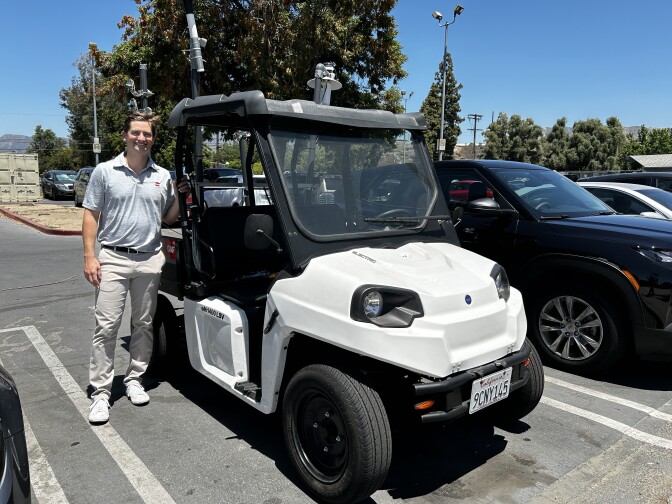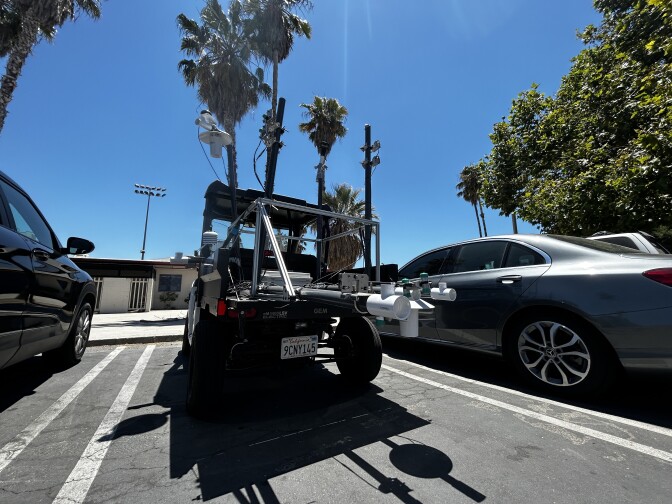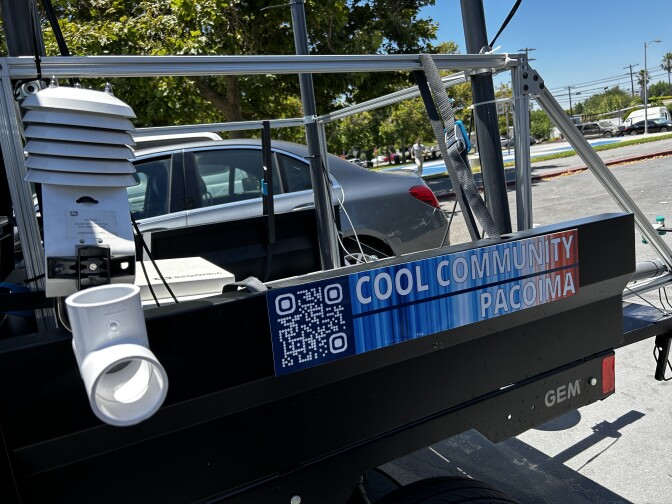Truth matters. Community matters. Your support makes both possible. LAist is one of the few places where news remains independent and free from political and corporate influence. Stand up for truth and for LAist. Make your year-end tax-deductible gift now.
To Fight Heat, Pacoima Started To Test A New ‘Cool Paint’ Last Year. The Results Are Becoming Tangible

The climate crisis is pushing average temperatures higher, and driving longer and hotter heat waves. And all the pavement in our cities only makes it worse.
“Cool pavement” may be one tool to help. It is a coating that can be applied to the surface of asphalt streets that can reflect solar radiation, rather than absorb it. But cooling the surface of a street doesn’t automatically mean a cooler community.
Pacoima is one of the hottest neighborhoods in metro L.A. And last year, they decided to test this technology. Ten square blocks of streets, an elementary school yard and a basketball court were covered with “cool paint." This week, we checked on the results.
Keeping it cool
As temperatures climbed to 95 degrees on a recent afternoon in Pacoima, the surfaces with “reflective paint” were 10 degrees cooler than regular old asphalt.
Preliminary research by the company that installed the paint, GAF Roofing, shows the pavement is helping to cool the ambient temperature of the whole 10-block area — and sometimes beyond — by as much as 3 degrees, possibly more.
But these “cool paint” technologies are new, so it’s not yet clear how much they can make a difference when it comes to our actual experience of heat. One thing that is clear: These paints are no silver bullet, and no replacement for improving tree cover, shade and green space.
GAF uses a modified electric golf cart to see how the cool coating may affect the human experience of heat in the neighborhood.
Challenges with pavement
Cool coatings may reduce the surface temperature of pavement dramatically, but actually make it hotter immediately above the surface, where people are. That’s what a 2020 study out of UCLA found with the type of cool pavement L.A. has used on some 10 million square feet of city streets over the last six years.
The coatings the city has used — put in the most simple terms — are asphalt-based with white paint mixed in, allowing them to reflect instead of absorb solar radiation.
But the coating in the 10 square blocks of Pacoima are acrylic-based. Eliot Wall, director of GAF Roofing's cool pavement program, said the company's proprietary mix of materials reflects solar radiation in long waves, rather than short waves — eliminating that increase in temperature just above the surface.

“What's unique about this coating is that there's an additive in it that actually reflects in a different portion of the radiation spectrum,” said Wall. “It’s not reflecting the visible light in the UV that can cause more heat and damage; it's actually in the long wave. So we're not seeing that same impact.”
The project where this coating has been applied is part of a partnership between GAF and community group Pacoima Beautiful, as well as the city of L.A., to better understand the impacts of cool pavement on the experience of heat and deploy cooling technologies in one of the city’s hottest neighborhoods.
Melanie Paola Torres, who grew up in Pacoima and is now a community organizer with Pacoima Beautiful for the cool pavement project, said community members are feeling a positive difference in the areas where the coating has been applied — and they want more.
“We’ve seen things that do work,” Torres said. “So we just keep hoping to add and stack onto that and really create a climate-resilient community.“
She said the next step is to pilot “cool roofs” in the area, so residents can benefit from the cooling effect at home.
Still, Torres and other experts know this is just one tool in the toolbox — research shows expanding tree cover, shade and removing pavement and adding green space are the ideal strategies when it comes to both cooling communities and improving quality of life.











